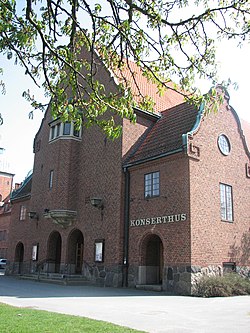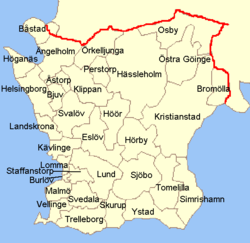Skåne
| Skánie / Skåne län | |
|---|---|
 | |
(c) Vladimir Sagerlund / Riksarkivet Sverige, CC BY-SA 3.0 znak (c) Vladimir Sagerlund / Riksarkivet Sverige, CC BY-SA 3.0 vlajka | |
| Geografie | |
| Hlavní město | Malmö |
| Souřadnice | 55°59′43″ s. š., 13°26′30″ v. d. |
| Rozloha | 11 302 km² |
| Časové pásmo | +1 |
| Geodata (OSM) | OSM, WMF |
| Obyvatelstvo | |
| Počet obyvatel | 1 402 425 (2021) |
| Hustota zalidnění | 124,1 obyv./km² |
| Jazyk | švédština |
| Národnostní složení | Švédové |
| Správa regionu | |
| Nadřazený celek | |
| Druh celku | län |
| Podřízené celky | 33 kommun |
| Vznik | 1997 |
| Landshövding | Margareta Pålsson |
| Mezinárodní identifikace | |
| ISO 3166-2 | SE-M |
| Označení vozidel | M |
| Oficiální web | www |
| Některá data mohou pocházet z datové položky. | |
Skánie (švédsky Skåne nebo Skåne län, latinsky Scania) je jeden z 21 švédských krajů (švédsky län) a také historická švédská provincie v nejjižnější části země.
Historie
Skåne náleželo do roku 1658 Dánsku, dlouhá staletí však bylo provincií, na niž si činilo nárok vedle Dánska, odděleného od ní úzkou úžinou, i sousední Švédsko, jehož organickou součástí z geografického hlediska území je; jako takové byla provincie předmětem a důvodem řady ozbrojených konfliktů. Definitivně pak připadla Švédsku v roce 1658 na základě ujednání smlouvy zvané roskildský mír a zabraná provincie byla v průběhu 17. a 18. století podrobena asimilační politice.
Geografie a administrativní členění
Nejvyšším místem regionu je Magleröd – 212 m n. m. Největším jezerem je Ivösjön. Na území Skåne se nacházejí tři národní parky – Söderåsen, Dalby Söderskog a Stenshuvud.
Území Skåne se nachází na poloostrově na úplném jihu Švédska, omývaném z jihu a východu Baltským mořem a ze západu úžinou Öresund. Sousedí na severu s regiony Halland a Kronoberg a na severovýchodě s Blekinge. Region je spojen s dánským ostrovem Sjælland mostem vedoucím přes úžinu Öresund. Sídly centrálních úřadů jsou města Malmö a Kristianstad, kulturním střediskem celostátního významu je také Lund.
Současný region vznikl 1. ledna 1997 po sloučení regionů Malmöhus a Kristianstad. Je rozdělen na 33 okresů. Jeho teritorium se překrývá (i když ne zcela) s územím historické provincie Skåne (Scania).
Region má rozlohu kolem 11 000 km². V roce 2004 zde žilo 1 159,4 tis. obyvatel, hustota zalidnění zde patří k nejvyšším v celé Skandinávii. Největším městem Skåne je Malmö, třetí největší město Švédska (290 078 obyvatel v červenci 2009). Další důležitá města jsou Helsingborg (87,9 tis.), Lund (73,8 tis.), Kristianstad (31,5 tis.), Landskrona (27,4 tis.), Trelleborg (24,9 tis.), Höganäs (24 tis. – r. 2008), Ängelholm (21,7 tis.), Hässleholm (17,3 tis.), Ystad (16,9 tis.) a Eslöv (15,5 tis.).
Turismus
Skåne je země zámků; návštěvníkům je přístupná většina z více než 200 staveb tohoto charakteru, jež kromě zhlédnutí vlastní památky nabízejí i řadu zajímavých atrakcí.
Zajímavosti
Latinský název Skåne – Scania – dal jméno strojírenskému podniku založeném v Malmö roku 1891, známém zejména výrobou nákladních automobilů (Scania).
Významní rodáci a obyvatelé Skánie
- Frans Gunnar Bengtsson, spisovatel a básník
- Tycho Brahe, dvorní astronom císaře Rudolfa II.
- Dietrich Buxtehude, barokní varhaník a hudební skladatel
- Eagle-Eye Cherry, popový zpěvák
- Anita Ekbergová, modelka a herečka
- Marie Fredrikssonová, zpěvačka
- Per Albin Hansson, bývalý švédský premiér
- Zlatan Ibrahimović, fotbalista
- Jarl Kulle, herec
- Henrik Larsson, fotbalista
- Birgit Nilssonová, operní zpěvačka
- Gustaf Wilhelm Palm, malíř
- Ruben Rausing, vynálezce Tetra Paku
- Gunhild Sehlin, autorka knih pro děti
- Stellan Skarsgård, herec
- Max von Sydow, herec
- The Sounds – rocková kapela
Odkazy
Externí odkazy
 Obrázky, zvuky či videa k tématu Skåne na Wikimedia Commons
Obrázky, zvuky či videa k tématu Skåne na Wikimedia Commons - Oficiální stránky
Média použitá na této stránce
Autor: TUBS
Location of xy (see filename) county in Sweden.
Autor: © 2003 Mic
2004 → polskie opisy (tsca), Licence: CC-BY-SA-3.0
mapka Skanii
(c) Vladimir Sagerlund / Riksarkivet Sverige, CC BY-SA 3.0
The banner of arms of the county of Scania, Sweden. According to currently valid heraldic norms and traditions, the proper flag of a Swedish county is the so called banner of arms. A banner of arms is essentially a coat of arms in flag form. It must not show the outer shield shape that arms are usually shown with, but it otherwise features the same design, adapted so that the contents satisfyingly fill up the available area. Any contingent accessories around the shield, such as crowns, helmets, or supporters, are left out.
The Swedish National Archives recommend the use of banners of arms, which stand in contrast to certain incorrect types of flags, such as ones bearing logotypes, or ones displaying the coat of arms as an escutcheon upon a unicoloured background. Such flags are inappropriate from various standpoints, including but not limited to heraldic, graphical, vexillological, and traditionalistic ones. But despite the county administrative boards being government agencies themselves, some of them utilize incorrect flags instead of the correct banner of arms.
In Sweden, county arms and their corresponding flags represent not only county administrative boards, but also counties as geographies. The heraldically correct county flag may be used by the general public to express regional identity, as long as proper procedures and customs are followed.
The griffin as a symbol of Scania has a long history. As the most important province that was ceded to Sweden as a result of the Treaty of Roskilde in 1658, Scania naturally needed to be represented with armorial bearings at the funeral of Charles X Gustav of Sweden in 1660, and it was in preparation for this ceremony that the provincial arms were created. It was councillor Gustav Bonde that suggested using the griffin's head from the arms of Scania's biggest city Malmö in the new provincial arms; the tincture of the field was however changed between the two, from silver to gold. Malmö's arms themselves are even older. They were granted in 1437 through letters patent issued by Eric of Pomerania, and it is from his own Pomeranian ducal arms that the Malmöite and Scanian griffin originates.
Scania County was created in 1997. The previous counties of Malmöhus and Kristianstad both bore griffin's heads in their respective arms. This, together with the fact that the newly established county is named after the historical province with the same borders, made the griffin's head a logical choice of charge in the new county arms. But unlike other counties sharing names with provinces with similar boundaries, the arms of Scania County are not exactly the same as those of the province of Scania: the county actually uses inverted tinctures from that of the province.
The arms of Scania County were registered with the Swedish Patent and Registration Office on the 5th of September 1997, with the following blazon (directly translated): "In a red field an erased griffin's head, crowned with an open crown, all of gold." This emblazonment was drawn by Vladimir A. Sagerlund when he was the heraldic artist at the National Archives.(c) Vladimir Sagerlund / Riksarkivet Sverige, CC BY-SA 3.0
Coat of arms of the county of Scania, Sweden. Painted by Vladimir A. Sagerlund when he was the heraldic artist at the National Archives of Sweden (Riksarkivet).













